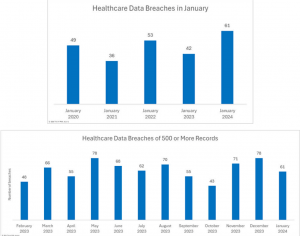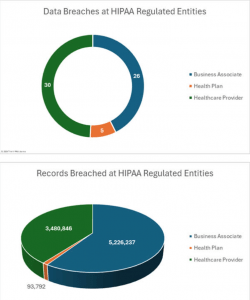Key Takeaways:
- Refer to the universally accepted accessibility standards like the WCAG (Web Content Accessibility Guidelines) to ensure healthcare app user experience (UX) optimization.
- A recent report of 61 data breaches of 500 or more records in January 2024 sheds light on the importance of privacy and security aspects during the healthcare app user experience (UX) optimization.
- Too many features, bright colors, and numerous graphics can confuse a user and can result in the uninstallation of healthcare apps. To avert such situations, use the ‘KISS’ (Keep it Simple Stupid!) strategy.
- Incorporate simple and consistent navigation patterns such as standard controls like menus, buttons, and tabs. Avoid unnecessary novelty or complexity that may confuse the users.
- Cater to trending technologies such as AI, NLP, and chatbots during the healthcare app UX optimization process because users are constantly looking for novel healthcare applications.
Imagine using an app that is non-interactive or is full of graphical images and bright colors. You may feel like uninstalling the application right away. The design of any mobile application determines whether a user will stay or choose to leave the app. But, what makes a great design? Which aspects compel people to stay and use the application long-term?
The answer may lie in the popularity of apps like Spotify and meditation apps (Calm/Headspace). Spotify’s ‘Wrapped’ feature allows the app to make personal recommendations based on the user’s data, and this is what sets them apart from others.
In the case of healthcare apps, users expect privacy and security of applications, along with seamless navigation and limited graphics. But, sometimes only these aspects aren’t enough to bolster the healthcare app user experience. The application needs constant optimization to meet the requirements of the users. This article will throw light on which factors to focus on during healthcare app user experience (UX) optimization. Here’s a checklist at a glance:
A Checklist for Healthcare App User Experience (UX) Optimization
To attract a target audience and increase the number of downloads for your healthcare app, designers have to do something extra. But, only increasing downloads won’t suffice, the app design should be such that users stay for a longer duration and recommend the app to others as well. To achieve this stage, here’s a checklist for healthcare app designers that will help them optimize the healthcare app user experience.
1. Design to Accommodate a Wide Array of Users
The idea is to optimize an application that serves a wide array of users, irrespective of their socioeconomic status and physical conditions. Accessibility and inclusivity in a healthcare application open doors for those who cannot travel for care, and it also paves the way for those who are differently abled.
A healthcare user experience grows tenfold when it is capable of accommodating people from diverse backgrounds. Design a healthcare app with features that are suitable for users with visual impairment, hearing disability, and cognitive dysfunctions. Some of the features to consider are
- Audio and video content pieces with captions + navigation
- Color contrast
- Font size that is suitable for the visually challenged
- Voice assistant features like Alexa and Siri
- Well-organized layouts and patterns, and universally acclaimed symbols
Refer to the accessibility standards like the WCAG (Web Content Accessibility Guidelines) to ensure healthcare app user experience (UX) optimization. These standards are universally accepted and the guidelines fall under four main categories: perceivable, operable, understandable, and robust. Read about the guidelines here.
2. Keep Privacy and Security as the Highest Priority
Healthcare apps tend to capture volumes of patient data in a day. This healthcare data also known as ePHI (Protected Health Information) encompasses crucial patient information such as demographics, contact details, medical history, diagnosis, and more. To maintain the privacy and security of this data, healthcare app developers must create an application that complies with certain rules. These rules are standards that ensure data security and privacy.
HIPAA (Health Insurance Profitability and Accountability Act) is the most widely used regulation during healthcare app design and development. HIPAA states that the application should comply with administrative, physical, and technical safeguards to ascertain the security of ePHI. This usually includes data encryption, user authentication, and regular monitoring of systems for potential cyberattacks.
The latest reports from the HIPAA Journal reveal that in January 2024, 61 data breaches of 500 or more records were reported to the HHS (U.S. Department of Health and Human Services) Office for Civil Rights.


Key reasons for the alarming rate of breaches are phishing, malware, and ransomware attacks by cybercriminals, threats incoming from untrained staff, inadequate encryption, lack of HIPAA risk assessment, and irregular monitoring of healthcare systems.
3. Tailor App Designs to Attract Maximum Users
Healthcare apps cater to the needs of a wide range of users – from differently abled to those facing chronic health conditions. One type of healthcare app may not be beneficial for all of them. So, tailored healthcare app designs may accommodate all types of users and enhance user experience and satisfaction.
Here are some key aspects that designers can optimize in healthcare app UX to make it more personalized:
- Branding and Visual Identity: Incorporate healthcare organizations’ brand identity through consistent use of colors, imagery, and typography. Build a visually appealing interface that instills trust and confidence in users.
- User-Centric Design: Conduct research on user preferences, and understand their behaviors, demographics, and pain points. Based on this data, optimize user experience that caters to the preferences of users. For instance, creating functionalities to meet the needs of cardiovascular or diabetes patients.
- Tailored Content: Provide content that is relevant to users’ medical conditions. Customize articles, resources, and videos to educate users.
- Include Progress Tracking Features: For healthcare applications focused on wellness and fitness apps, offer tools for users to monitor their progress. Graphs, charts, and visual representations of their achievements can motivate users to do more and gain newer heights.
- Personalized Notifications: Offer options to users to personalize notification settings based on their preferences. With this option, users can have control over the timing and frequency of notifications.
By customizing the healthcare app user experience (UX), designers can craft user-centric applications and attract maximum users.
4. Apply the ‘KISS’ Strategy
Why do some UX designs work superbly and some don’t? Well, one of the major reasons for this situation is building a complex user interface. Too many features, bright colors, and numerous graphics can confuse a user and can result in the uninstallation of healthcare apps.
To avert such situations, use the ‘KISS’ (Keep it Simple Stupid!) strategy. Get rid of unnecessary clutter by optimizing the healthcare app user experience (UX). This leaves room for elements that users exactly want.

One of the ways to implement the ‘KISS’ strategy is to work backward. Instead of brainstorming for an ideal layout and pattern, designers can think about how their target audience will interact with the application. This thought process can help designers find everything they need to optimize the app effortlessly. For example, a designer may find a GIF to be an enticing feature, but if it doesn’t serve its purpose to lure users, then it doesn’t fulfill the goal.
One of the best examples of the ‘KISS’ strategy is the Google home page. It is simple, with plenty of white space, with one search bar and the name ‘Google’ written over it. Another example is that of Airbnb, the page looks complex and alluring but is simple to use and intuitive.
5. Don’t Miss Out on Navigation
Another essential aspect of healthcare app user experience (UX) optimization is to ensure that all users can navigate the application effortlessly. Healthcare apps are loaded with a wealth of content and features, hence a seamless navigation system is essential. Here’s what needs to be done for it:
- Consistent Navigation Patterns: Incorporate simple and consistent navigation patterns such as standard controls like menus, buttons, and tabs. Avoid unnecessary novelty or complexity that may confuse the users.
- Visual Cues: This includes colors, icons, and animations that guide users through the navigation process. Consider highlighting interactive elements for better clarity.
- Search Functionality: Incorporate a search feature that allows users to find specific features and content within the application. Offer relevant search results and suggest autocomplete options to assist users in their search queries.
By focusing on these aspects, designers can optimize navigation features and make them more intuitive and efficient.
6. Include a Balanced Set of Visual Elements
Visual elements make a healthcare app appealing. It is what sets it apart from the crowd. A brand’s identity is showcased through visual elements. So, include a fair amount of visual elements during the user experience optimization process.
- Use High Contrast Colors: High color contrast ameliorates readability and assures that crucial elements stand out on the screen. Color contrast is essential for the visually impaired and for those functioning under high-stress conditions.
- Avoid Too Many Animations: Animations can be attractive, but too much of it can be distracting and disturbing at the same time. The main focus of healthcare apps should be accessibility and clarity on visual elements, and not creating chaos.
- Usage of Right Fonts: All text needs to be clear, accessible, and readable, so all those with cognitive disabilities or visual impairments can navigate the application easily.
By optimizing these elements, designers can enhance the healthcare app design user experience tenfold and attract volumes of users.
7. Harness Trending Technologies
The incorporation of cutting-edge technologies takes the user experience optimization process to newer heights. Users are constantly looking for apps filled with the latest technologies, and if your app has one then users are going to download your application over others.

Here’s a list of trending technologies that designers can implement:
- Artificial Intelligence (AI): AI-driven designs capture user data and offer personalized user experience. Algorithms capture user behavior to create interfaces suitable for each individual.
- Voice-to-Speech Assistance: This technology leverages NLP (Natural Language Processing) to convert text-to-speech and voice-to-speech. A perfect technology for the visually impaired and bedridden patients.
- Chatbots: These are a part of AI and are trained to answer user queries, book appointments, and assist users in their healthcare journey.
8. Fill Designing Gaps via Testing and User Feedback
The last way for healthcare app user experience (UX) optimization is by filling those tiny design gaps. User feedback and testing are two plausible ways to do it.
Comprehensive and robust testing is the key to optimizing healthcare app experiences. This assures that an application is running smoothly, features work as expected, and offers a positive user experience.
Seek feedback from users to upgrade the application and the best way to do it is by gathering data through AI. Plus reviews left on Play Stores also help to optimize apps for the best user experience.
If you’re looking to optimize your healthcare app UX then look no further, we at Arkenea have got you covered. Our expertise lies in the healthcare domain and we offer solutions for healthcare mobile app development. We also provide services for healthcare app support and maintenance, along with its modernization. Hop on to a consultation call with us to know more.
